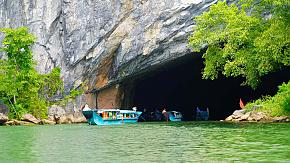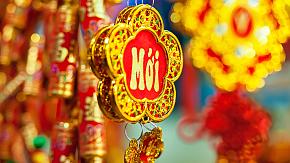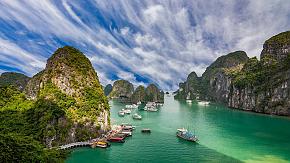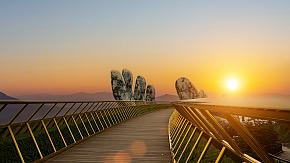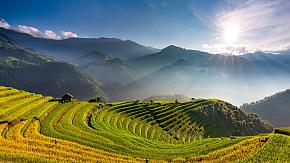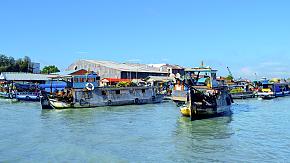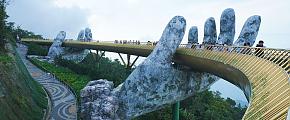What to See in Hue and Hoi An: Top Places in Central Vietnam
It suddenly struck me that most of Vietnam's many attractions have names beginning with the same letter "H'. It's probably just a coincidence, but still interesting. Or maybe I'm just a geek! Whatever, I've written here before about Hanoi, Halong Bay and Ho Chi Minh City. Today, I want to look at two more "H" destinations.
HUẾ
Huế, lying on the banks of the Perfume River (Sông Hương or Hương Giang), near Vietnam's eastern shore and the South China Sea, was the capital of the Đàng Trong Kingdom (1738 to 1775) and again the capital of the Nguyễn Dynasty from 1802 to 1945. As an imperial city, Huế has had a huge influence on Vietnam's culture, cuisine and even clothing.
 The Perfume River
The Perfume River
Áo Dài
The famous áo dài, the tight fitting tunic worn with trousers which is today mainly exclusive to women, but was originally for both genders, had its birth here back in the 18th century. Đồng Khánh Girl's High School adopted the áo dài in 1917 for its school uniform, winning much praise for the elegance of its pupils. Later the costume was modified under the influence of the French colonizers and their Parisian fashion designers. The design most often seen today came about in the 1950s and is a national symbol for the whole of Vietnam.
 Tableau showing couple worshiping while wearing old unisex áo dài
Tableau showing couple worshiping while wearing old unisex áo dài
Citadel of Huế and Imperial City
On the northern bank of the Perfume River is the Citadel of Huế (Kinh thành) and within its bounds is the old walled Imperial City (Hoàng thành). Built here by Emperor Gia Long starting in 1802, Huế Imperial Palace was the center of power in Vietnam until the French imposed their rule in the 1880s. Within the Imperial City is a second city, the Purple Forbidden City modeled on Beijing's Forbidden City. Like the Chinese original, the Purple Forbidden City was reserved for the emperor, his concubines and closest advisers. Anyone else entering would be executed.
 The Imperial City of Hue
The Imperial City of Hue
After the fall of the Nguyễn Dynasty in 1945, the imperial city was abandoned and fell into disrepair. Of the 160 buildings here originally only 10 remain. It was also badly damaged during the Vietnam war. Restoration and repair work is continuing to this day.
The citadel contains Huế Museum of Royal Antiquities which displays the arts of the imperial times along with associated objects. Also here are the elaborate tombs of several Vietnamese emperors: Minh Mạng (died 1841), Tự Đức (died 1883), and Khải Định (died 1925) among others. Tự Đức was the longest serving Nguyễn Emperor (1848-83), but surprisingly is not buried in his tomb! 100 laborers were ordered to build and bury the late emperor in a secret location. When they returned from the job, to ensure the secrecy, they were all beheaded immediately. To this day, his true resting place remains unknown.
The citadel and imperial city are open daily from 08:00 to 17:30, except Thursdays when it remains open until 22:00. Hue Imperial Palace (Imperial City - Hue Museum of Royal Antiquities) admission is đ150,000 VND (approx $6.50 USD) for adults and đ30,000 VND ($1.30 USD) for children aged 7 to 12.
The three tombs attract an entrance fee of đ100,000 VND ($4.30 USD) for adults and đ20,000 VND (just under $1 USD) for children. All conversions are approximate and are based on January 2020 exchange rates.
Huế Imperial Cuisine
Huế's status as a royal capital had a huge influence on the local cuisine, with Vietnam's best chefs coming up with dishes fit for the palate of an emperor. This delicious food spread out of the palace and into the streets, giving the city a unique cuisine and today Huế is considered to one of the country's top eating destinations. Huế's food has a reputation for being spicier than other Vietnamese food.
Probably the most popular in Huế is bún bò, a rice noodle soup made by boiling beef meat and bones with lemongrass to make a stock, which is then seasoned with fermented shrimp sauce and sugar. The stock is then used to cook thin slices of beef, oxtail and pig's knuckle. Rice noodles are added along with a dash of chili oil. Traditionally, bún bò is served with lime, cilantro / coriander leaf, green onions, banana blossom mint, basil, perilla and various Vietnamese herbs such as rau răm (Vietnamese coriander) and ngò gai (saw tooth herb). There is fish sauce and shrimp sauce on your table to adjust the soup to your own taste.
Also very popular is bánh khoái, which is a refined version of the bánh xèo found everywhere else in Vietnam. These shrimp and vegetable deep fried pancakes are made from a rice flour batter containing turmeric and coconut milk and stuffed with prawns, pork and carrot. They are deep fried and served with a peanut dip containing finely minced pig liver. They are accompanied by the usual salad of lettuce, mint, and perilla.
Other dishes include cơm hến (baby basket clams with rice), bánh bột lọc (Vietnamese clear shrimp and pork dumplings) and bánh ướt thịt nướng (steamed rice pancake with grilled pork). The best places to eat these dishes and more are in Huế's many small restaurants which can be found all over the city.
Huế is a pleasant city to stroll in, taking in its colonial architecture, the riverside and the tree lined streets.
HỘI AN
Today's second "H' destination is Hội An in Quảng Nam Province, 121 km / 75 miles south of Huế. Historically, an important trading port, the city became extremely rich in the 16th century. By the 18th century it had become the most important trading port in south-east Asia with strong connections to China, India and Japan as well as further afield. The ceramics industry was very important to the city and ceramics from Hội An have been found as far away as Egypt.
 Hoi An Old Town
Hoi An Old Town
At the beginning of the`19th century, the new emperor, Gia Long thanked the French who had helped him gain power, by awarding them exclusive trading rights in the nearby port city of Đà Nẵng which became the new center of trade in central Vietnam and Hội An was all but forgotten. It is also possible that the port had lost its appeal as the river mouth was becoming silted up, although some historians dismiss that theory. Whatever the reason, it meant that Hội An became frozen in time. Only some 200 years later, did it re-emerge almost fully preserved. In 1999, Hội An Old City was listed by UNESCO as a World Heritage Site for being "an exceptionally well-preserved example of a South-East Asian trading port dating from the 15th to the 19th century."
Hội An Old Town
Hội An Old Town is like a living museum with its 16th to 18th century architecture, Chinese temples, wooden houses and shops, old canals etc. Many of the old houses have been converted to restaurants and bars. Perhaps, the most famous landmark here is the Japanese Covered Bridge (Chùa Cầu Nhật Bản). This bridge, opened in 1719 was built by the Japanese traders living here to link to the Chinese quarter on the opposite bank of the river. It was renovated in 1986.
At either end of the of the colorfully painted, 18 m / 60 ft bridge stand sculptures of dogs and monkeys symbolizing that the bridge construction started in the year of the dog and ended in the year of the monkey, by the Chinese zodiac system. On the northern side is a Taoist temple dedicated to the God of Weather (Trấn Vũ Bắc Đế). Local artists gather on the bridge to sell their paintings.
Three minutes' walk from the Japanese Bridge is Tấn Ký Old House (Nhà cổ Tấn Ký), once home to an 18th century Vietnamese trader and lovingly preserved by his family for seven generations. The brick and tiled building remains almost exactly as when it was first built. The thick walls and wooden furniture inside means that it is warm in winter and cool in summer.
The highly symbolic architecture features a mix of Vietnamese, Japanese and Chinese themes and motifs, reflecting that these three peoples lived and worked together in Hội An during its heyday. Beside the central courtyard, look out for the two panels inscribed with Chinese characters - look closely and you will see that every stroke of the characters is actually a picture of a bird. There are exactly 100 birds, this representing perfection.
The Fujian Assembly Hall (Hội Quán Phước Kiến), built around 1690 is the most famous of five such halls in the old city for traders from different parts of China to socialize with their hometown counterparts while living in or just visiting Hội An. The others are the Chaozhou, Hainan and Cantonese halls, plus a general Chinese hall. Inside the highly photogenic Fujian hall building is a temple dedicated to the goddess of the seas and protector of sailors. Don't miss the fertility shrine where childless couples come to pray.
Evenings are a great time to visit the old city, especially by the riverside. Everywhere you look you will see colorful lanterns and equally colorful local vendors out to sell their wares. Street performers do their thing and the atmosphere is wonderful. If you are lucky enough to be here at the time of a full moon, it is especially fantastic as all the bars, restaurants, shops etc, turn off all their lights and just rely on candles and lanterns, while local musicians play their traditional Vietnamese instruments, poets recite their poetry and people play Chinese chess.
 Beautiful lanterns in Hoi An
Beautiful lanterns in Hoi An
The area is full of restaurants and bars, both Vietnamese and international and there are plenty of roadside stalls selling snacks and there are simple restaurants with simple but delicious and very cheap Vietnamese specialties.
A ticket is required to enter the Old City and costs đ120, 000 VND ($5.20 USD.) The ticket is valid for you to come and go during your time in Hội An. It also includes entry to 5 of 21 specific attractions within the old city (including most of those listed here), but this expires after 24 hours. Get your sightseeing in early!
But there is more to Hội An than just the old city. Get out and explore elsewhere, too.
Chúc Thánh Pagoda
Founded by a visiting Chinese monk, in 1454, Chúc Thánh Pagoda (Chùa Chúc Thánh) is the oldest Buddhist temple in Hội An. With its mixed Vietnamese and Chinese architecture, the two storey temple sits in a peaceful garden 2 km / 1¼ miles north of the Old Town. With signs written in ancient Chinese characters, animal carvings, pillars and murals, it is a peaceful spot to spend some time.
Kim Bồng Woodworking Village
Kim Bồng Woodworking Village (Làng mộc Kim Bồng) lies across the Thu Bồn River from Hội An. In the 15th century and onwards, it was home to a large community of carpenters. It was noted for its cabinet making and shipbuilding, supplying the traders of Hội An with their needs as well as contributing their skills as far away as Huế. With the decline of Hội An as a trading port in the 18th century, this almost came to an end. Only a handful of master carpenters and carvers remained until the 1990s when local authorities decided to revive the village and its reputation for fine work. A program was put in place to allow young people to receive free carpentry and woodworking training. They were given the tools they needed and paid a small stipend during their apprenticeship.
Huỳnh Ri, a master carver in his seventies, the last of 12 generations of woodcarvers in his family, gave training as did other woodworking studios. By 2008, there were over 200 newly trained woodworkers in the village and 18 different woodcarving companies. Many have found employment in restoration work, both in Hội An and Huế.
In 2002, the village was promoted as a tourist site by the Vietnam National Administration of Tourism (VNAT) together with UNESCO and the United Nations Conference on Trade and Development/World Trade Organization. The many visitors now contribute greatly to the area's economy, reducing poverty and improving the lives of the local community. The success of the scheme has led to it being adopted as a model for sustainable tourism projects across SE Asia.
I have merely touched on the many attractions these cities and this part of Vietnam have to offer. I didn't even mention the beaches! Next time. Both Huế and Hội An can be included in any Vietnam tour. Just tell us your preferences, budget, etc. Within 24 hours, Odynovo's travel experts will custom design you a personal itinerary for your consideration. You can go to places not beginning with "H", too!
Quick Question
Related Posts You May Like
What Our Clients Say
Explore the latest verified reviews of Odynovo's travel services on Tripadvisor, Google, Trustpilot, Product Review and more trusted platforms.
SUBSCRIBE TO WIN A FREE TOUR
Subscribe to our newsletter for a chance to win a free 7-day tour to India! And more insider travel news, exclusive offers, and inspiration will be sent straight to your inbox. Check our previous newsletters and get some sparks.

